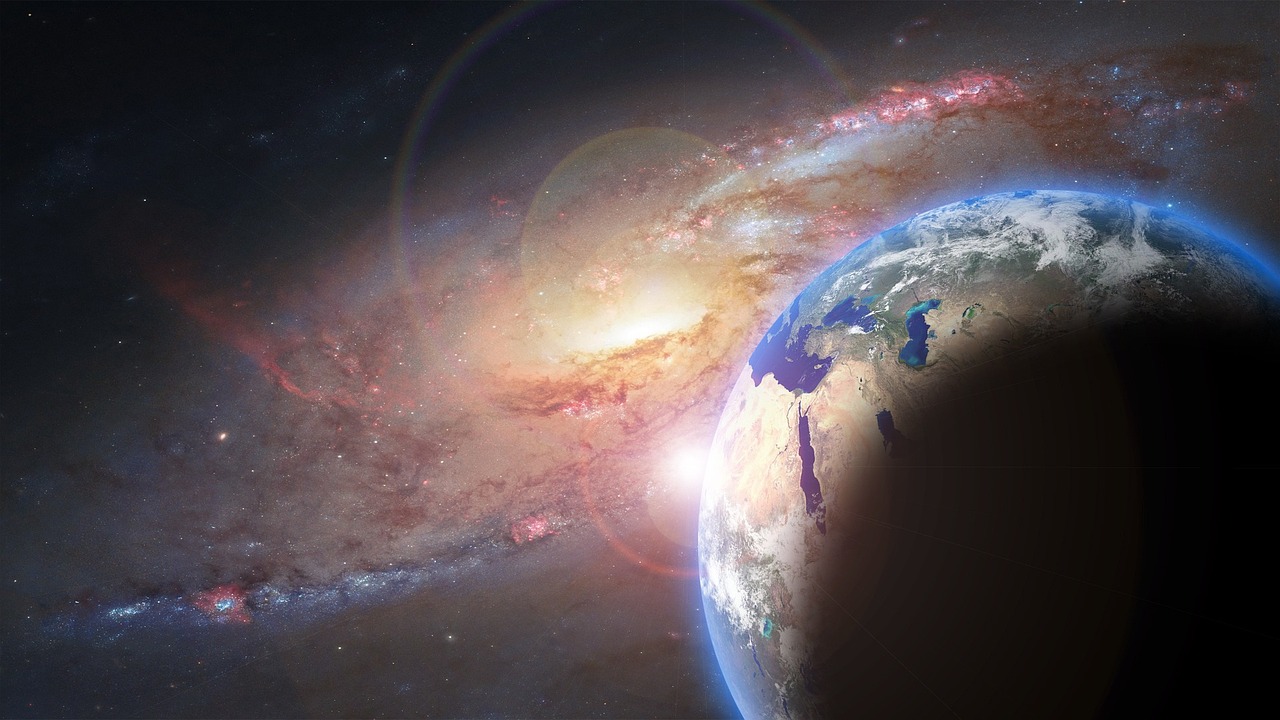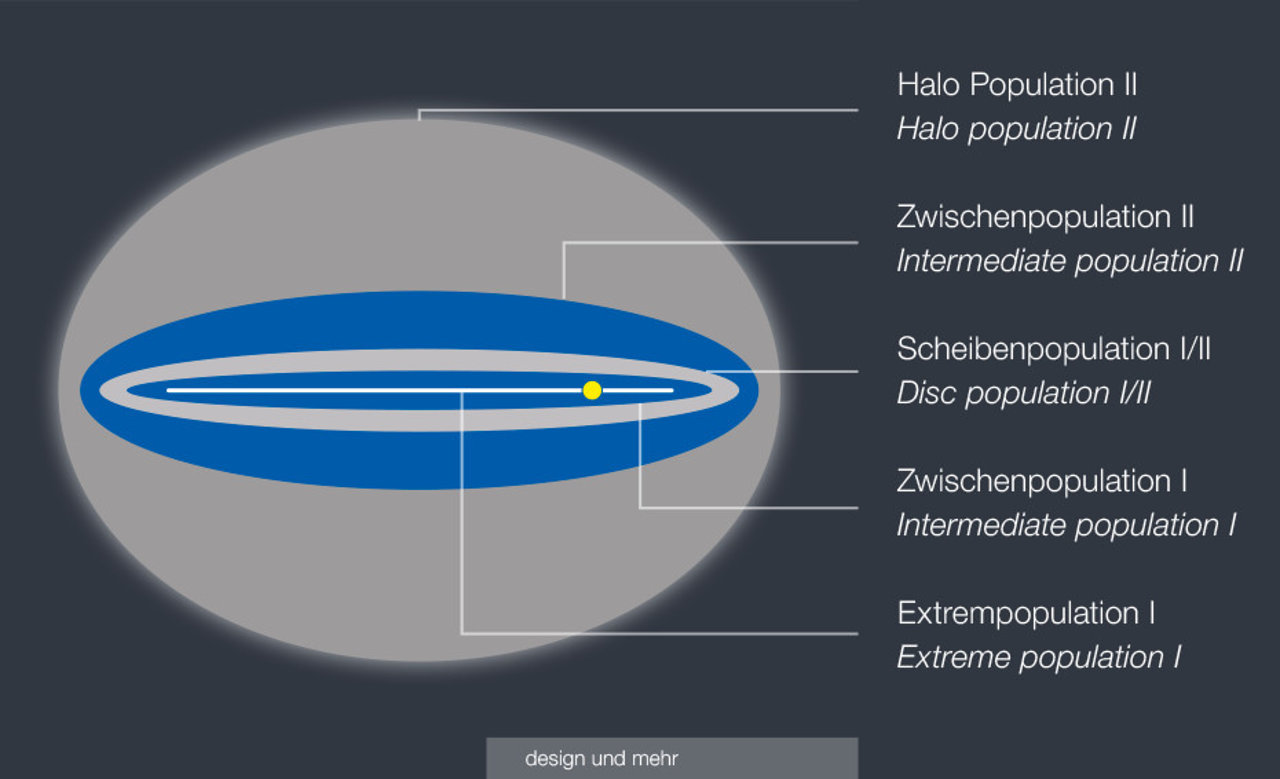Stardust and eternity – 3.1.4
Stellar populations
Stars in the Milky Way often differ not only in their location and spatial distribution, but also in their chemical composition and age. In the 1940s, while observing the electromagnetic spectra of stars in the nearby “twin” spiral galaxy Andromeda – also known as M31 – German astronomer Walter Baade realised that the stars of the flat spiral disk were “bluer” (or younger) than the “redder” stars found in the bulge at center in the Andromeda galaxy. These bright, hot, massive blue stars are now known to be young and short-lived, while the bright red giant stars are old and long-lived. This is why he named the two types of stars mentioned above “Populations I” and “Populations II” respectively. He later realised that the same difference in colour between the two stellar populations also occurred in our Galaxy: indeed, Population I were located in the spiral arms of the Milky Way, while Population II stars compose the globular clusters populating the spherical “galactic halo”, which surrounds our galaxy. Badee’s idea was later refined in terms of the age, location, and composition (or metal content) of stars; furthermore, a third “Population III” was finally added to the original classification.
The “Population I” stars are confined to the plane of the galaxy and follow nearly circular orbits around the galactic centre, taking about 240 million years to revolve around it. These stars are not evenly distributed in the disk, but are mainly concentrated in the galactic spiral arms – often surrounded by interstellar matter and giant molecular clouds. Although normal stars are mainly composed of hydrogen (about 3/4) and helium (about 1/4), the abundance of the small remaning percentage of heavier elements or “metals” – created in the very interior of massive stars during their evolution and later ejected during their death – stronlgy differs aboung them. As time passes, new forming stars incorporate more and more heavy elements from the surrounding interstellar matter that compose their stellar nurseries, thus becoming heavier in terms of metals. In Population I stars, heavy elements make up about 1-4% of the total stellar mass. This implies that the stars in this category are younger than average. For instance, the young, massive and luminous stars of the Orion Nebula – formed just a few million years ago – are classical examples of Population I stars. So is our Sun, which is about 5 billion years old, but is still younger than the Milky Way, which is almost as old as the Universe (13.7 billion years).
“Population II” stars are mainly confined to the galactic halo and central galactic bulge. They do not follow circular orbits, nor are they confined to the galactic plane. These are stars that formed early in the history of our galaxy – around 11-13 billion years ago, when the abundance of metals was low. Only low-mass Main Sequence (i.e. hydrogen-burning) stars, with a longer life span, are still visible in the globular clusters that populate the galactic halo: stars more massive than the Sun have left the Main Sequence, becoming “red giants” or “white dwarfs”. Stars that belong to this stellar population have much lower abundances of heavy elements, even lower than 1/100th of the concentrations found in the Sun.
“Population III” stars are the hypothetical very first stellar objects that formed in the Universe, arising from the gigantic interstellar cloud that originated our galaxy. These stars would have been almost entirely composed of hydrogen and helium with approximately zero metallicity and are supposed to have left behind the interstellar clouds from which the Population II stars formed. However, today we have no trace of these stars, probably because they were very massive (and therefore very short-lived) and because they have already exploded into supernovae, leaving behind only compact remnants – such as neutron stars and black holes. The detection of population III stars in other galaxies is one of the major goals of NASA’s recently launched James Webb Space Telescope.


Further resources
Links below will redirect you to external websites. In accordance with the European data protection declarations, we would like to point out that by clicking on these links you may send data to external providers. We cannot prevent that.
Images
![]() Stellar populations (ESO)
Stellar populations (ESO)
![]() First Stars: Composition (STScI)
First Stars: Composition (STScI)
![]() First Stars: Temperature, Brightness, and Color (STScI)
First Stars: Temperature, Brightness, and Color (STScI)
Videos
![]() Stellar Populations and Formation of the Galaxy
Stellar Populations and Formation of the Galaxy
![]() Types of Stars – Population I, II and III Stars And Their Properites
Types of Stars – Population I, II and III Stars And Their Properites
On line resources
![]() Stars – Stellar Populations (AstronomyOnline)
Stars – Stellar Populations (AstronomyOnline)
![]() Populations I and II (Britannica)
Populations I and II (Britannica)
Further readings
![]() Evolution of stars and stellar populations (M.Salaris, S.Cassisi)
Evolution of stars and stellar populations (M.Salaris, S.Cassisi)
Teaching Material
![]() Teaching Astronomy with an Inquiry Activity on Stellar Populations (Arxiv)
Teaching Astronomy with an Inquiry Activity on Stellar Populations (Arxiv)
For Kids
